Five School Lunch Heroes Doing Essential Work Right Now
In honor of School Lunch Hero Day, we’re sharing snapshots of incredible school nutrition professionals working to feed kids through the COVID-19 pandemic.
Help nourish students’ minds, bodies, and hearts this holiday season!
In honor of School Lunch Hero Day, we’re sharing snapshots of incredible school nutrition professionals working to feed kids through the COVID-19 pandemic.
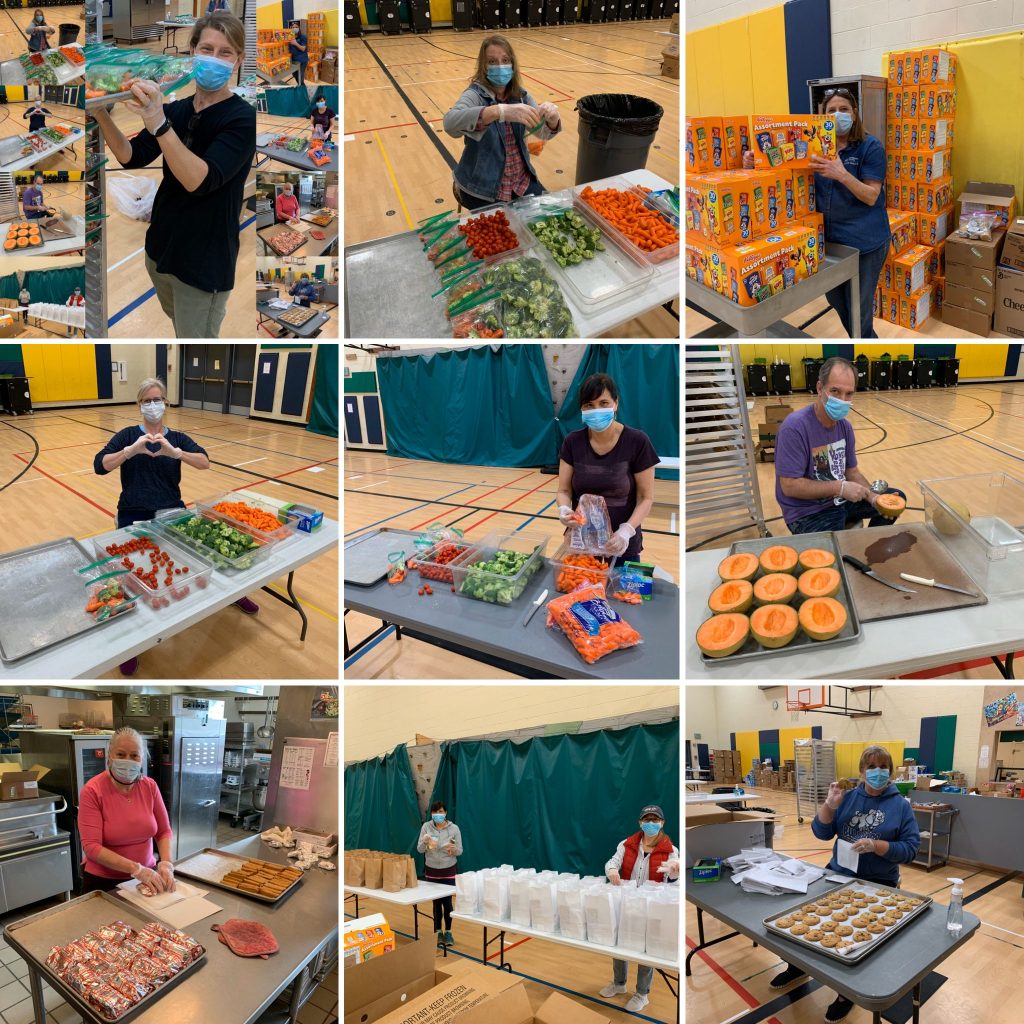
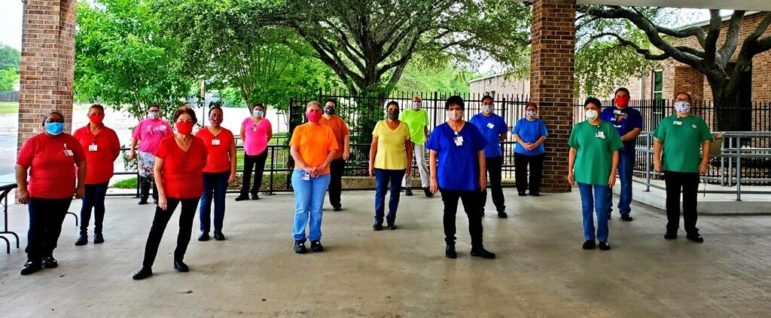
Anne Leavens, Nutrition Services Supervisor for Central Point School District 6 in Oregon, is one of thousands of school nutrition professionals whose world has turned upside down since COVID-19 closed schools across the country. Still, she’s hopeful.
“All the committed staff that work every day give me hope. Seeing all the families leaving their homes to come get meals gives me hope. It’s nice to know how many committed staff members we have willing to continue to come in and prepare food and serve our community,” she says. “The group I have working right now makes me proud to say I work in school nutrition!”
School Lunch Hero Day, the brainchild of graphic novel illustrator Jarrett Krosoczka, in partnership with the School Nutrition Association, is celebrated every year in early May. The timing this year could not be more fitting, as school cafeteria teams from one coast to the other continue the most extensive emergency food service effort in our nation’s history.
Indeed, Krosoczka joins the rest of America in being so inspired by the dedication and creativity of the nation’s school nutrition professionals, he declared this entire past week a cause for celebration.
In that same spirit, FoodCorps shares snapshots of five school nutrition directors, one for each day of the week—and each representing a formidable team of heroes getting the recognition they’ve long deserved.
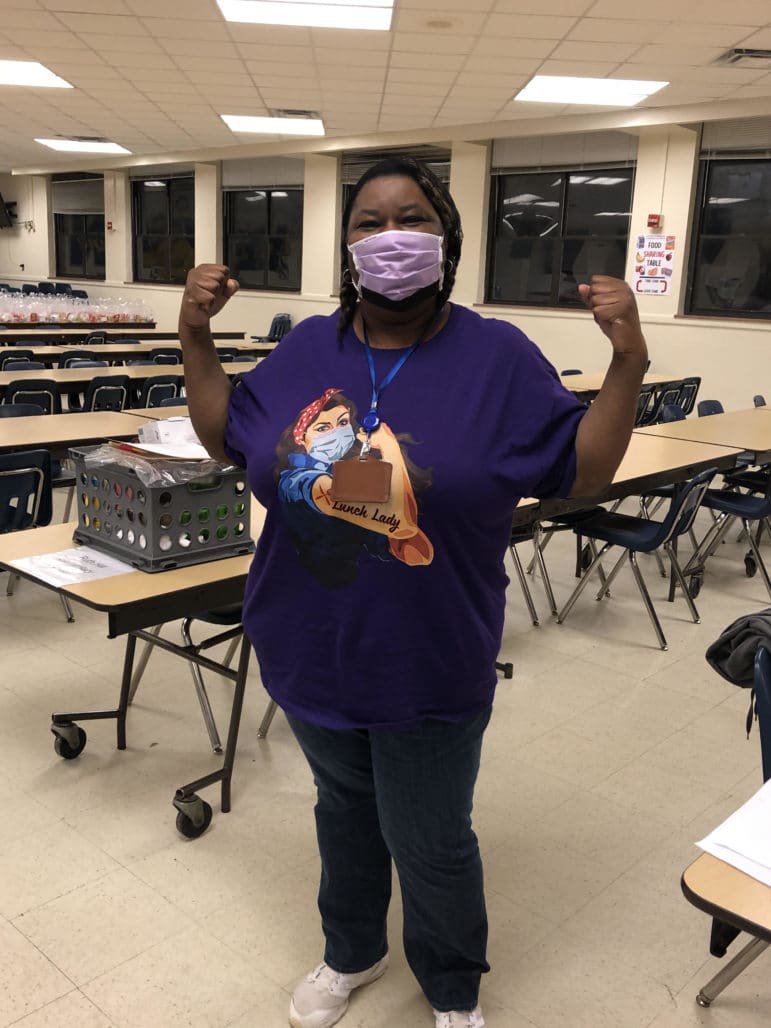
It was a Tuesday evening, and Keshia Williams was celebrating. She’d just gotten approval to start her school district’s first summer meals program. She’d have only eight weeks, give or take, to pull together all the details. Little did Williams know that she and her team would be launching a similar program a mere seven days later.
“We didn’t have transport equipment. We had no idea how to project for participation. We’d never done deliveries. We didn’t know if we had sufficient packaging. We had to get everything—all the food and equipment—from our individual schools to one central site. It was uncharted territory,” recounts Williams, School Nutrition Director for Georgia’s Coweta County School System.
The first week, the Coweta school nutrition team distributed 5,823 meals from six sites. This past Monday alone, they prepped and served more than 5,100 meals in a single day. And the totals show no sign of slowing. On Wednesday, “All of our meal sites were ‘sold out.’ Even though we prepared more meals, based off of Monday’s projections, we were still about 20 short,” Williams says.
In the space of seven weeks, the Coweta team has added two more drive-through distribution sites and is providing breakfast, as well as lunch. To limit exposure and protect both team members and their community, they prep and serve five days’ worth of meals—including hot lunch entrees—on three days: Monday, Wednesday and Friday.
It’s undeniably stressful, especially with the constant anxiety that one team member might get sick and that would mean the whole operation is shut down. It’s expensive; her district has committed to paying all staff, even if they are not working all (or any) of their normal hours. And given that meal counts are below “normal” school participation levels, the operation can’t look forward to the federal reimbursements that normally offset those costs.
But those who are working are motivated, Williams reports. “They aren’t here for the paycheck—they are here for the students. While the prep work can be monotonous, they love going to the distribution sites and seeing ‘their’ kids. They come back to the prep kitchen rejuvenated. We are tired, but so inspired. Just when I think it isn’t possible, every day, I fall more and more in love with my team.”
Once the crisis has passed, Williams believes that folks in Coweta County will remember what an important role school nutrition played. “We’re part of the community every day, not just during a pandemic.”
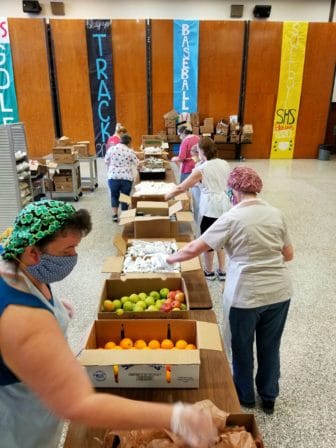
In Kansas, the total enrollment of Prairie Hills Unified School District #113 is just 1,163 students, but the district covers a large, widespread rural area. Food Service Director Brook Brubeck has a deep appreciation for the necessity of school meals—perhaps more than many of her peers.
With the same title and range of responsibilities, her position is hourly, compared to the salaried positions of her peers in larger districts. To make ends meet, Brubeck works additional jobs outside of the school district, and she has had periods where she’s relied on SNAP benefits. “I know firsthand how difficult it will be for families to feed their kids, because I personally worry about feeding my own kids,” Brubeck shares.
“I worry every single vacation, every summer break—and those are the days I can plan for. But this? A global pandemic shutting down schools for the rest of the year? Our families are worried.”
Still, Brubeck remains laser-focused on the professional demands of this unique period in school meal history. “I had a million thoughts and worries and contingency plans and questions every single second of every day,” she recounts. “But I can honestly say that for all the worry and weariness and anxiety, I never once thought for a single second that maybe we shouldn’t do it. Not once.”
Brubeck had a bit more planning time than some of her peers in other states—school buildings closed during spring break, which gave her extra days to formulate an emergency meals approach that would begin once “classes” resumed. Nonetheless, the break presented its own staff communications challenges, and she was largely on her own in putting a plan together.
She takes deserved pride in her early decision to keep food preparation and meal distribution responsibilities completely separate. “As the illness progressed across the country, and we saw what was happening in other districts, I realized that to sustain our program, I needed to insulate my prep team in our kitchen,” Brubeck explains. “So, after the first week of service, we brought in volunteers—teachers, paraeducators (or classroom aides), custodians and bus drivers—to actually serve the meals.” For both groups, she requires twice-daily temperature checks be taken.
Brubeck admits to being periodically disheartened when she encounters pushback for school-based programs like emergency meals or summer food service. Still, she’s glad to see her team gaining recognition for their collective efforts. “I hope people remember that we were there, every single day. And that we’re always essential, every day. We deserve respect and a seat at the table when decisions are being made about our students,” she says. She and her team have served 30,000 meals since schools closed.
This crisis has also uncovered a personal silver lining. “To be quite honest, before this, I was floundering. Burnt out. I didn’t feel I was making a difference and was getting bogged down in the minutiae and personnel issues. I didn’t have the passion anymore,” Brubeck says. “But this has made me remember the reason why I do what I do: I make sure hungry kids get fed. I help families shoulder the burden of making ends meet. I help alleviate the fear about where the next meal will come from. That’s what I do. That’s what I’m passionate about.”
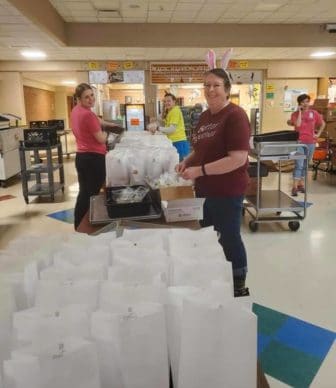
“I’ll put my team up against anybody’s,” says Michael Gasper, Supervisor of Nutrition Services, School District of Holmen, Wisconsin. He not only credits his team’s spirit and dedication during weeks (and weeks) of emergency meal service, but he is awed by their creativity and capability to pivot repeatedly. “It’s so cool to have a weekly Zoom meeting together, everyone sharing ideas and positive attitudes of ‘We can do this’ and ‘We can do that,’” he explains.
The Holmen District made the decision to close schools a week ahead of the governor’s mandate, and did so with no advance notice. “Friday, March 13 was the last day. Our team had conversations late on Friday, then again over the weekend and we started implementing the plan on Monday,” Gasper recounts. Curbside meals weren’t even in the original approach, as the advisories about social distancing had yet to be issued. “We’ve just kept tweaking and changing as we go.”
Breakfast was added to meal distribution in the third week. Three initial distribution sites merged to mitigate risk of exposure. Five days of pickup service were reduced to three. Staff teams rotate, with each taking a separate day of the week.
“We’ve become way more efficient over time,” Gasper reports, pointing, as an example, to a system of laminated windshield signs that denote the number of meals needed for each car and that has proven crucial in keeping things moving along. “One of our team leaders came up with that one,” he says, noting that the pandemic is demonstrating “how adaptable we are as an industry—it’s pretty phenomenal.”
The first week, the Holmen Nutrition Services department served 2,000 meals; last week, it was more than 10,000. Menu changes, which are promoted on Facebook, help to drive participation at the pickup sites, just as they would in the cafeteria. “Today, we’re serving pizza, so we expect to have more kids than ever,” Gasper says. A popular “Lucky Tray Wednesday” promotion has been adapted to a “Lucky Bag” version—and little touches like these help retain the warm and welcoming environment that is a hallmark of Gasper’s operation. “We’re passionate about the service we provide for the kids. It’s what we do every day—and it’s who we are.”
Gasper puts a lot of faith in “the positive stories coming out of this mess.” He notes that “school nutrition has been much maligned over the years, even though it’s nothing like it was even just 10 years ago. I think it’s interesting that the lowest-paid group in the school district is the one that’s putting in the most work and is the one considered ‘essential,’” he points out, hoping greater awareness might go a long way to raising salaries in the future.
As most U.S. schools begin their third month of closures, the strain of social distancing, anxiety about an unpredictable future, and the monotony of days rolling together is starting to show. And yet, when Ally Mrachek walks into her school prep kitchens in Fayetteville Public Schools, Arkansas, she finds her spirits buoyed by her staff. “I can see they’re smiling through their face masks,” she says. “They give me hope through this. They being who they are [is what] keeps me going.”
Mrachek, Director of Child Nutrition, and a FoodCorps AmeriCorps alumna, recognizes that the district’s students also are lifted by the “bit of normalcy” found in their cafeteria staff continuing to distribute school meals. “Seeing their faces is a nice connection and provides a lot of hope,” she says. “It’s comforting in a really abnormal and scary time.”
Fayetteville’s Child Nutrition team has been distributing a week’s worth of meals every Tuesday at five sites to the tune of 14,000 meals every time. While proud of this achievement, Mrachek admits to being somewhat dismayed by the 180-degree turn the school meals operation has taken: from her efforts to boost scratch cooking and custom meals back to relying more heavily on shelf-stable packaged items.
But she hasn’t given up. “We’re still trying to buy from local growers,” Mrachek says.
While one of her core goals will always be to help kids appreciate fresh produce and rely less on heavily processed menu items, school meals are, she says, “a hunger relief program, now more than ever. There is a major connection between school food and families that really need it.”
She hopes that the current crisis will build greater empathy in the community for her team of school lunch heroes who keep showing up for kids. “I am so, so proud of my staff. They are doing it. There was no hesitation to come to work. They are putting their health at risk for these kids,” Mrachek says.
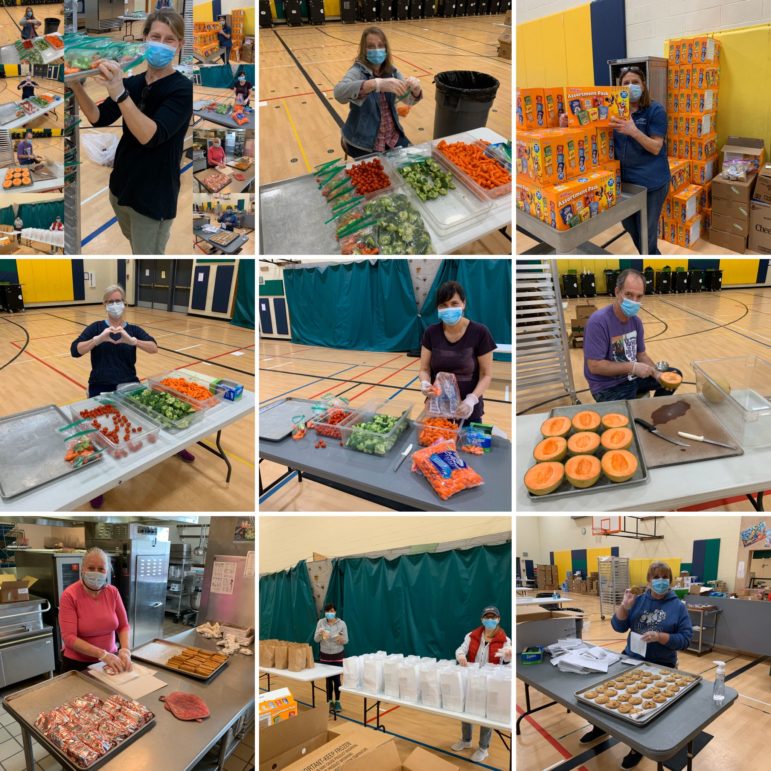
Washington’s Bainbridge Island is a ferry ride from downtown Seattle, says Eric Boutin, Food & Nutrition Services Supervisor. It’s home to a small-ish, affluent school district of about 4,000 students, with less than 7% qualifying for free or reduced-price meals. Nonetheless, since “flip-of-the-switch” school closures prompted a full-scale crisis response, Boutin and his team have been serving some 900 students every day, which is close to their normal reimbursable meal counts.
Meals can be picked up at one central school site or delivered to families across the island who are unable to collect meals in person. The “food service team” has expanded, Boutin credits, to include paraeducators, bus drivers, and administrators who have volunteered to help. “What I will remember most from this period is how this team—staff and community—came together to ensure kids feel supported and nourished.”
And the community has responded with equal enthusiasm. “It would be difficult for me to overstate the outpouring of support and appreciation our community has expressed for the work of the food service team,” says Boutin. “Scores of parents have said that the daily lunch ‘drive-through’ is the highlight of their child’s day, helping to support feelings of connection and community.”
Like many of his peers, Boutin is looking at the upcoming school year with some hopeful anticipation. “We are starting discussions with principals and administrators about what could be possible,” he says. “A good nutrition program is such a foundation for children’s physical health, social-emotional connections, and effective education. I am hopeful that we will come out of this with an imaginative and thoughtful approach to how a school meal program can ensure all children have the nutrition they need to thrive—and that approach should include federal funding for universal meals.”
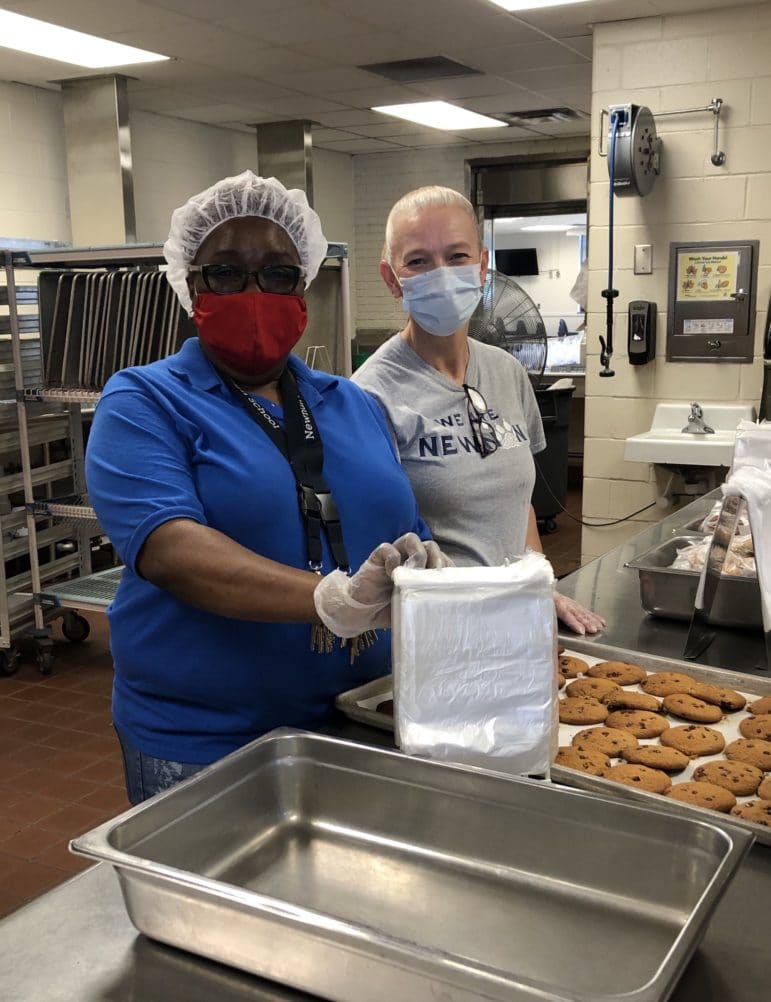
School nutrition professionals are more than heroes: they are essential. As Congress works on the next COVID-19 relief package, we need your help in ensuring school food is included in any recovery plans. Congress must provide much-needed protections and support so that school nutrition service operations can survive this pandemic financially and continue providing access to nutritious food.
Tell your elected officials that future COVID-19 relief legislation must protect school nutrition staff by ensuring they can access personal protective equipment (PPE), and provide funding for school nutrition programs.
FoodCorps is a non-partisan, non-profit organization. FoodCorps staff and FoodCorps AmeriCorps members may not participate in any partisan or seemingly partisan activities during work time charged to a Corporation for National and Community Service funded grant or while earning AmeriCorps service hours. No federal funds were used to prepare or distribute these advocacy actions.
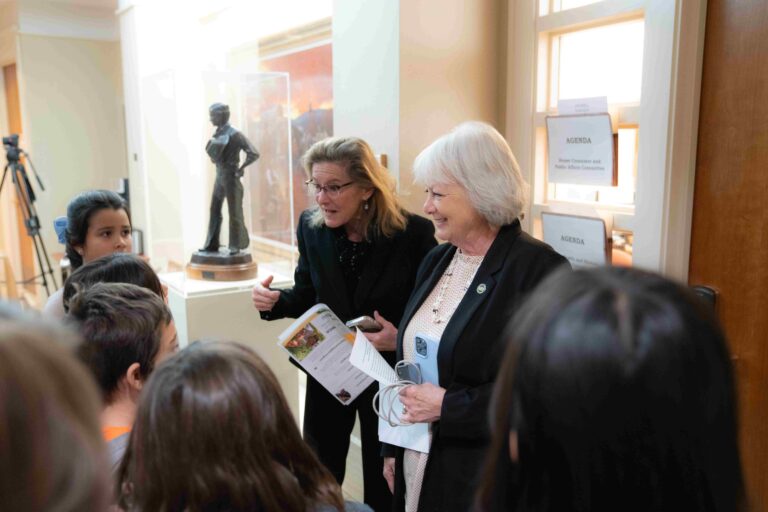
Our 2025 Child Nutrition Policy Year in Review
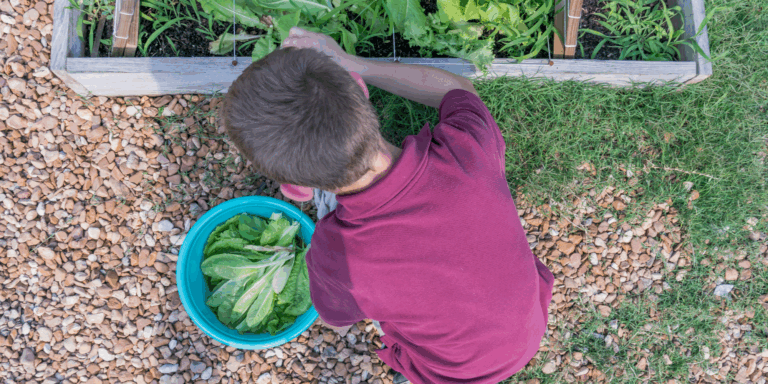
Winterizing Your School Garden

5 Awesome Small Businesses by FoodCorps Alums